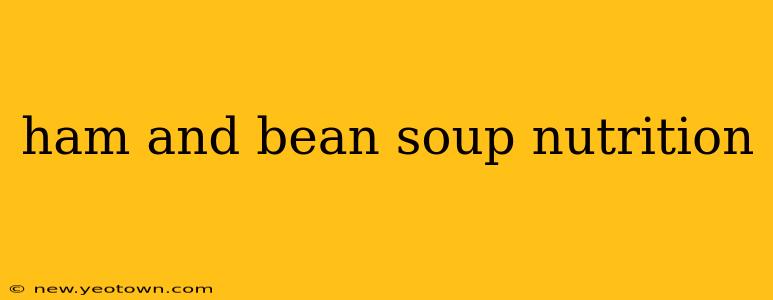Ah, the aroma of ham and bean soup simmering on the stove – a culinary hug on a chilly evening! But beyond its comforting warmth, this classic dish packs a surprising nutritional punch. Let's dive into the delicious details of this hearty and healthy meal.
What are the nutritional benefits of ham and bean soup?
Ham and bean soup is a nutritional powerhouse, offering a balanced blend of protein, carbohydrates, and fiber. The beans contribute significant amounts of protein, fiber, and essential vitamins and minerals like folate and iron. The ham adds protein and a savory depth of flavor, while the vegetables (often carrots, celery, and onions) contribute vitamins, minerals, and antioxidants. The exact nutritional content varies greatly depending on the recipe, the type of beans used, and the amount of ham included. However, a typical serving generally provides a good source of several essential nutrients.
Is ham and bean soup good for weight loss?
This is a question with a nuanced answer. While ham and bean soup can be part of a healthy weight-loss diet, it's crucial to be mindful of portion sizes and ingredients. Beans are incredibly filling due to their high fiber content, which can help with appetite control. However, ham, particularly processed ham, can be higher in sodium and fat. To make it more weight-loss friendly, opt for leaner cuts of ham, reduce the amount of ham used, and load up on vegetables. Using broth instead of a creamy base also reduces the overall calorie and fat content.
How many calories are in a bowl of ham and bean soup?
The calorie count varies dramatically depending on the recipe and serving size. A typical serving could range anywhere from 200 to 400 calories or more. Factors influencing the calorie count include the type of beans (kidney beans are generally higher in calories than navy beans), the amount of ham, added fats (like oil or butter), and the presence of other ingredients like pasta or potatoes. To get a more precise calorie estimate for your specific recipe, you can use online nutrition calculators or consult a nutritionist.
What are the potential health risks associated with eating ham and bean soup?
While generally healthy, there are a few potential health concerns to be aware of:
- High Sodium Content: Ham can be high in sodium, contributing to high blood pressure in individuals sensitive to sodium.
- Processed Meat: The use of processed ham increases the risk of sodium and nitrates/nitrites. Look for lower sodium options or consider using fresh ham.
- Bean-Related Gas: Beans are a good source of fiber, but this can lead to gas and bloating for some individuals. Start with smaller portions and gradually increase your intake to allow your body to adjust.
- Purine Content: Some beans are higher in purines, which can be problematic for people with gout.
Is ham and bean soup suitable for diabetics?
Ham and bean soup can be included in a diabetic-friendly diet, but moderation and careful ingredient selection are key. Beans are a good source of fiber, which helps regulate blood sugar levels. However, it’s crucial to monitor portion sizes and be mindful of the carbohydrate content, particularly from added ingredients like potatoes or pasta. Consult with your doctor or a registered dietitian to determine how ham and bean soup fits into your individual dietary plan.
Conclusion: A Delicious and Nutritious Choice (Mostly!)
Ham and bean soup offers a delicious and satisfying way to enjoy a nutritious meal. By making smart ingredient choices—choosing leaner cuts of ham, opting for low-sodium options, and loading up on vegetables—you can maximize the health benefits while minimizing potential risks. Remember to always practice mindful eating and adjust portions to suit your individual dietary needs and preferences. Enjoy your bowl!

